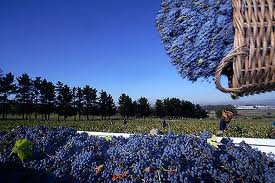Here wine farming is a creative act, and dedication to soil and vine a way of life. Grown as bush vines, the crop is limited by extensive pruning, making it possible to produce quality grapes under absolute dry-land conditions, and the wines are made with minimal intervention, using traditional French natural fermentation techniques.
The Dumas family has been making wine on the estate for three generations, with present owner Cornelis Dumas helped by his son Hannes, who will eventually take over the reins. Cornelis ascribes his success with natural fermentation to a squeaky clean cellar where no bacteria is given a chance to ruin the wine.
It is situated between Stellenbosch and Kuils River, with its vineyards planted on the slopes of the hills overlooking False Bay, less than 10 km away. The soil of the 85 ha planted to bush vines has a gravelly, sandy loam structure with yellow clay as its base. A broadly organic approach is followed in growing the vines, and kraal-manure from the mixed farming with sheep and cattle on Jacobsdal is used extensively as fertiliser in the vineyards.
Good drainage and water-retention make it possible to produce quality grapes – small berries with an intense concentration of flavour – under dryland conditions. None of the vines are irrigated. The vineyard rows lie in line with the direction of the prevailing summer wind, the south-easter, which not only cools down the vineyards but also keeps the vines healthy reducing crop-spraying to the minimum.
The estate’s signature wine, Pinotage, is produced from vines covering some 20 ha of the estate and growing at an altitude of 140 m above sea level. On the cool slopes the small berries produce a wine portaying some of the elegance of the Pinot noir parent. At Jacobsdal, wines are genuinely hand-made. Little has changed in the old cellar dating back to 1920. The must is fermented in open tanks. No commercial yeast has ever been used in the cellar and fermentation is allowed to develop spontaneously from the natural yeast cells on the grape skins. Researchers believe a unique yeast strain has developed in the vineyards and in the cellar which imparts a broad spectrum of desirable characteristics to the must. During fermentation, the cap of skins is punched through regularly into the juice using long wooden poles with crossbars to extract optimal colour, flavour and tannins.
The wine is matured in small casks of French oak for 18 months, and allowed to settle in the bottle before being released. For decades the Jacobsdal Pinotage was the only wine sold under the estate label until the first Jacobsdal Cabernet Sauvignon (vintage 2001) was released in 2004.



